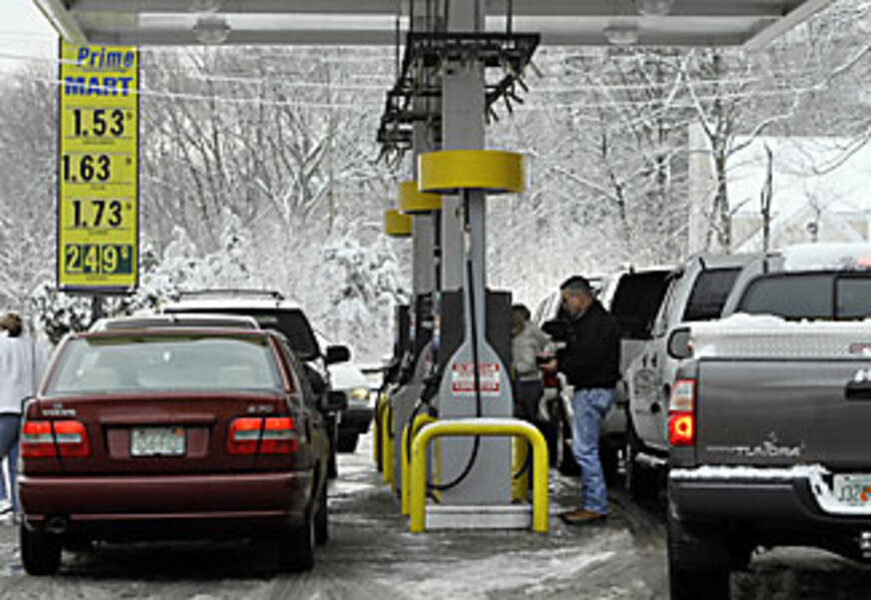Economic bright spot: energy prices
| New York
The best economic news that consumers receive next year could be the price they pay for energy.
Although it's almost 2009, prices at the pump – close to $1.65 a gallon – are below what Americans paid in 2004. That year, the top three bestselling vehicles were pickup trucks, and gasoline prices averaged $1.85 a gallon for regular.
Also this winter, residents of the Northeast are expected to see their heating costs shrink by almost 25 percent when compared with last winter.
"It's a bit of a gift, like a giant tax cut," says Sarah Emerson, managing director of Energy Security Analysis Inc. in Wakefield, Mass. "This is one of the best things to happen to the economy over the next six months."
In 2009, the price of gasoline will average $2.03 a gallon, the Energy Department forecasts. While this number is higher than current prices, it's much lower than 2008, when gasoline prices averaged closer to $3.27 a gallon and crested at over $4 a gallon in July.
"We think oil prices will start to recover slowly next year," says Tancred Lidderdale, a short-term energy forecaster at the Energy Information Administration (EIA) in Washington. "But it is hugely uncertain, and a lot depends on the economy."
Crude oil prices will average about $51 per barrel next year, Mr. Lidderdale forecasts. His projection mirrors the price on the futures market, where oil for delivery in December 2009 is priced at $52 a barrel.
On Wednesday, the price of oil was just over $37 a barrel.
Still, private forecasters are expecting a wide range in oil prices next year. "If things go really bad, you could see oil prices dropping to $10 to $11 a barrel," says Phil Flynn, a vice president at Alaron Trading Corp. in Chicago. "It's more likely to fall to $25 a barrel on the low side and by the end of the year be back to the $70-a-barrel level."
Much will depend on whether the Organization of Petroleum Exporting Countries can rein in its production. OPEC's production in 2008, according to the EIA, will total about 32.18 million barrels of oil per day. In 2009, it will drop to 30.61 million barrels per day, the agency estimates.
"OPEC says they will cut [production], but it's a big challenge for a couple of countries, Venezuela and Iran in particular," says John Felmy, chief economist at the American Petroleum Institute (API) in Washington. "Both face challenges of social unrest if they don't have the income from oil."
Making OPEC's goal even tougher is new production coming on stream from non-OPEC nations such as Brazil and the United States. This adds about 410,000 barrels a day to global supply, the EIA estimates.
"OPEC is really the swing supplier, or has been," Lidderdale says. "As demand falls, it's up to OPEC to cut supplies to stabilize prices."
Indeed, demand continues to fall. Worldwide demand for crude oil will drop 500,000 barrels per day to 85.3 million barrels per day, the EIA estimates. The drop is already much greater in the US. In November, the API reported, demand was down 6 percent for the year – just over 1 million barrels per day.
The bullish psychology that pushed oil prices to a high of about $145 a barrel in July has turned in the oil markets. "Clearly, in this past summer there was more speculation in the oil markets than we thought," says Mike Fitzpatrick, director of research at MF Global in New York. "It might have been worth $50 to $60 a barrel."
Going into the new year, Mr. Fitzpatrick says, the oil markets are fixated on how low prices can go. "People are watching demand drop in China, and that weighs on prices."
China energy watchers expect demand in the country to continue to slide over the next several months. Paul Ting of Paul Ting Energy Vision in Short Hills, N.J., is monitoring fuel-oil consumption, used for electrical production, as an indication of the strength or weakness of the Chinese economy.
"What I am seeing is weak electrical demand, which says GDP growth is weak," he says.
With electrical demand off, he says, fuel-oil production is down about 20 percent in China. "November was extremely weak, weaker than anyone thought," he says. "Looking ahead next year, the first half will be a continuous difficult environment."
Declining consumption also means rising heating-oil inventories in China. Historically, he says, the Chinese have carried less than 10 days of inventory coverage. That is now up to more than 30 days. "It reflects the fact supply is way in excess of demand," he says.
Back in the US, consumers will get a break this winter on their heating bills. For those who use natural gas, winter bills are expected to decline by only 1 percent. But home heating oil in the Northeast is now about 75 cents a gallon lower than in December last year, EIA surveys are finding. For the entire heating season, fuel-oil bills could be 24 percent lower, depending on the weather, Lidderdale estimates.
Over the next 10 days, temperatures over the Northeast should moderate, says Scott Bernhardt, a meteorologist with Planalytics, a weather forecasting service for business in Wayne, Pa. But winter will return later in January and February, he warns.
"We can expect some cold weather and some very fast-moving storms," he says. "Merchants don't need to put out the shorts yet."






